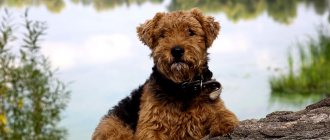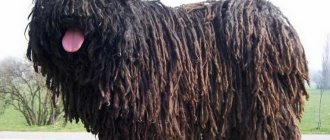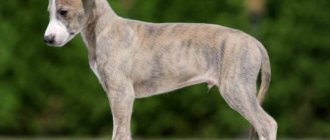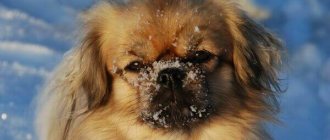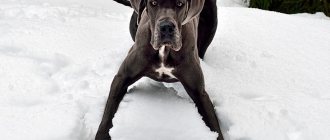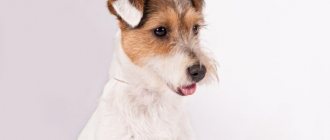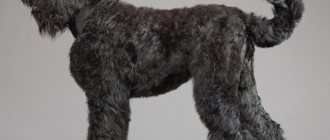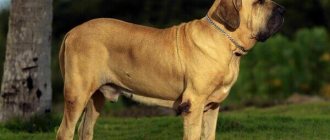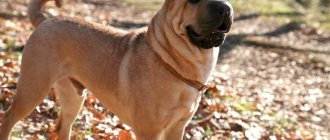Breed standard and description
English greyhounds are usually divided into 3 types:
- Hunters;
- Runners – participate in dog racing;
- Exhibition dogs are representatives of the breed that meet breed standards.
Weight: 30 kg; Height at withers: 70-75 cm.
Body: Looks lean and muscular.
Skull: flat. Curve as it transitions from forehead to nose.
Eyes: oval shaped, brown.
Ears: small in size, thin, slightly raised on cartilage.
Neck: long, muscular
Chest: wide.
Ribs: visually defined, deep.
Belly: tucked in.
Paws: long, smooth, muscular.
Back: rectangular. The spine has an arched shape. Elevation in the lumbar region.
Tail: carried low and long. Its tip is narrowed relative to the base.
Coat: Short, fine and soft. Without pronounced undercoat.
The peculiarity of dogs of this breed is long jaws with a scissor bite.
Color: black, white, red, blue, fawn, fawn, brindle, harlequin. A combination of colors with white spots is allowed.
Disqualifying features
- Deviations from breed standards;
- Aggressive behavior;
- Cowardice;
- The presence of congenital defects of a physical or psychological nature.
Advantages and disadvantages
Peace-loving and non-intrusive, the gray is considered an ideal companion dog. The Greyhound is completely devoted, selflessly loves and understands its owner perfectly. The dogs’ pleasant appearance and subtle mental organization will not leave indifferent those who are trying to get to know the breed better.
Grays are considered aristocrats of the dog world, having a high level of intelligence, communicating with a great deal of tenderness with every family member, acquaintances and relatives of the owner.
Disadvantages include difficulties in training, such as disobedience and the freedom-loving nature of the dog. It is also very important not to make a mistake in choosing a puppy, since the differences between the working classes and the exhibition category are very strong. Show dogs are definitely not suited for hunting, and the working class in the ring, to put it mildly, is much inferior in its exterior qualities to its show rivals.
History of the English Greyhound
It is believed that the English greyhound is a direct descendant of the Saluki or Sluggi, the very first domestic dogs. But genetic research in 2004 showed that greyhounds are related to sheepdogs and are not related to Salukis.
The most plausible version says that the English greyhound descended from the Celtic greyhound, . Celtic tribes brought them to the British Isles around the 5th century BC.
It is known for certain that already in the 10th century the English greyhound was a favorite breed among aristocrats. According to the Forest Law, issued in 1014, only members of the nobility were allowed to keep greyhounds.
In 1776, the first British hunting club was opened by Lord Orford, a passionate hunter, breeder and breeder. He infused the Greyhounds with the blood of the Old English Bulldog . As a result of the experiment, the animals strengthened their bones , but their appearance remained the same.
Subsequently, greyhounds were divided into 3 subtypes: hunting, racing and exhibition. It is worth noting that dogs of different subtypes are prohibited from crossing with each other. Thanks to this, greyhounds are considered the property of the English kingdom.
Greyhound diet
Greyhounds do not require complex care, but their feeding has certain features. They must be taken into account when preparing your pet’s daily diet. In particular, a feature of the breed is its small stomach volume. These dogs cannot eat a lot, so they need to be fed more often, but in small portions. Greyhound puppies should eat plenty of animal proteins. They are necessary for proper growth, development of muscles and ligaments.
The main source of protein should be meat. Lean beef is ideal. Pork can harm the health of the animal and should not be given to it. Also, your pet’s diet should contain fats and carbohydrates. There must be two types of carbohydrates: easily digestible and difficult to digest.
The first type will support the proper functioning of the intestines, the second will provide the dog’s body with energy. The inclusion of vegetables, some fruits and cereals in the diet will allow you to provide your pet with sufficient fiber. Cereals can be cooked in broth.
If your diet consists exclusively of natural products, you will need to purchase additional vitamins and minerals. Their selection should be carried out together with a veterinarian. You can also use dry food to feed your pet. Dry food will save the owner from the need to prepare food for the dog every day and buy vitamin complexes. However, this option is quite expensive. Only super-premium food is suitable for a Greyhound, and it is not cheap.
Who is the Greyhound suitable for?
Depending on the breed subtype, the owner must be:
- hunter;
- a fan of greyhound racing;
- participate in dog shows.
Greinhounds are hunting dogs and are not suitable for service or home guarding. Some people believe that dogs of this breed have a crazy character. But they are more balanced than terriers. They like to be close to a person ; if left alone, the pet becomes lethargic and sick.
Greyhounds love their family . They sense the mood of their owners and are unobtrusive. Owners note that these dogs detect changes in the intonation of the owner's voice. Also, pets do not tolerate rude treatment.
Greyhounds get along well with children , as well as with other animals in the house. But rather, this concerns relationships with dogs and cats; birds and rodents awaken the hunters in them. Therefore, the guinea pig will have a hard time.
Character Standards
Greyhounds are very smart dogs. They quickly understand what a person wants from them and carry out commands without whims. The dog tries in every possible way not to anger its owner. Showing character by trying to dominate the house is not the style of English greyhounds. The main character traits of dogs is their friendliness. They love affection, they always climb under your hands to be petted.
The animal is active, but only if it is allowed to run and jump. Without commands, greyhounds will not chase around the yard or park after the prey they like. In the house they behave like real aristocrats - they like to sleep or calmly watch their household members from a lying position.
At home, greyhounds love to lie on a soft surface, so they need to arrange their own personal beds, otherwise the dogs will climb onto chairs and sofas
At first they behave warily towards strangers (both animals and people), but do not show aggression. They adapt to strangers quickly - as soon as they understand that their owner is friendly towards the stranger, they will immediately come up to introduce themselves.
Watchmen and guards from greyhounds turn out to be useless. These are companion dogs with a very friendly character. They will not bark or attack aggressors (their first defensive reaction in case of danger is to run and hide). They get along well with children. They take part in common games with pleasure. They get along easily in the same house with other pets.
English greyhounds do not tolerate loneliness and love company, so it is recommended to have greyhounds in pairs
Maintenance and care
Greinhounds are lazy pets. They love to lie on the sofa. To prevent your pet from becoming completely lazy, you should walk him every day for at least an hour .
The Greenhound will be an excellent companion for joggers . When such walks become a habit, your pet will become more willing to go outside.
Due to the lack of undercoat, it does not tolerate frost . Therefore, for walks you need to get warm overalls.
Maintenance is easy. The fur once a week using a damp palm or rubberized glove. Once every 3 months, the pet is bathed using dog shampoo.
Healthy Greenhound eyes are shiny, without excessive tearing or souring. Once every 7-10 days they are examined and wiped with a cotton swab or disk soaked in warm water.
To keep your pet's teeth healthy, brush them once a week . To do this, use a special toothpaste for dogs.
The animal's paws should be washed after walks with a cloth or washcloth. They must be carefully inspected for mechanical damage.
Feeding
Greyhounds are generally unpretentious eaters and have a good appetite. Most breeders prefer premium food. You can feed your pet in a combined way, but you should not mix two types of food: natural and special food at one time.
For natural nutrition you should include the following products:
- Lean meats: chicken, turkey, rabbit, beef;
- Sea fish without bones;
- Boiled eggs (1 time every 7 days);
- By-products;
- Vegetables: cabbage, beets, carrots, etc.;
- Greenery;
- Cereals: rice, oatmeal, buckwheat;
- Vegetable oil - 1 teaspoon per day.
Before serving, the meat must be frozen at a temperature of -15-20 degrees for a minimum of 2 weeks. Before serving, it must be completely defrosted and doused with boiling water.
must have fresh, clean water freely available in a separate container.
It is forbidden:
- Boiled bones;
- Spicy, fried, sweets, smoked foods;
- Fatty meats;
- Raisins and grapes;
- Nuts and chocolate;
- Bony fish.
Interesting facts about greyhounds
In English, the name of the breed sounds like Greyhound. It cannot be translated literally, but there is an opinion that the name means “gray greyhound”. Other experts claim that the name of the breed comes from the word “gazehound”, which means a dog that hunts using its sight.
Greyhounds are different from all existing hounds. They have a unique heart. It is very large in size. Additionally, dogs have the highest percentage of fast-twitch muscle fibers of any breed. All these features make Greyhounds excellent runners. They were recognized as the fastest dogs in the world.
Despite their naturally strong immunity, endurance and great speed, greyhounds do not tolerate cold well. They can even shake when it rains. This is due to the fact that these dogs have a small percentage of subcutaneous fat and very short hair.
Greyhounds should not be walked without a leash. The animals have a well-developed hunting instinct. They may suddenly chase a cat, squirrel or any other animal. It will be difficult to catch up and find your pet later. Let him off leash only in a safe or fenced area.
Dogs of this breed need socialization. They need to be socialized from puppyhood. Otherwise, the dog will be afraid of strangers and have psychological difficulties adapting to new circumstances and terrain.
Many people are afraid to own Greyhounds because of their high energy levels. However, this is not quite true! Dogs of this breed need activity, but most of the day they prefer to sleep or just lie down. They can live peacefully even in a city apartment.
Raising and training a dog
The English greyhound is people-oriented, so house training does not cause trouble for the owner. Training a Greyhound to be completely submissive is a difficult task.
You can achieve results if you cooperate with a professional. Complex commands will have to be learned with a dog handler.
If nothing complicated or supernatural is required from your pet, then you can train the puppy yourself. The main thing is that the animal trusts its owner.
Pros and cons of greyhounds
Greyhounds are dogs with a long list of advantages. They are calm, reserved and obedient. With proper upbringing, such a dog will never disobey its owner or cause him problems. At home, the animal will behave calmly, almost unnoticeably.
Another advantage of the breed is its friendly attitude towards people and other dogs. The pet does not show aggression without reason, will be able to make friends with children, and will peacefully coexist with other dogs in the same territory.
The indisputable advantage of the breed is its deep affection for the owner. Greyhounds are very loyal dogs. They listen to their owner unquestioningly if he pays attention to the pet from an early age, training him and socializing him on time. It is impossible not to note the dog’s intelligence and sharp mind as a plus of the breed. These animals are understanding, quickly grasp new material during training, and are very inquisitive and playful.
Among the disadvantages of the breed, one can note its excessive curiosity in puppyhood. Greyhound puppies should not be left alone for a long time, because they strive to stick their nose into any hole. Until a certain age, puppies will need constant supervision. Another disadvantage is the fear of cold.
Dogs do not tolerate wet and frosty weather well. Another significant disadvantage of the breed is its pronounced hunting instinct. If the dog is not socialized in time, then his passion for hunting will develop into a real problem. If there is a cat in the apartment, the dog may even kill it.
Health and life expectancy
Representatives of the Greyhound breed have enviable health and live up to 14 years . They rarely have hip dysplasia, which is common in other long-legged dog breeds.
Common diseases:
- Cataract;
- Progressive retinal atrophy;
- Anomaly in the development of the tear ducts;
- Age-related arthritis;
- Deafness (white dogs);
- Hypothyroidism;
- Allergic reactions to medications.
Attention! Dogs of this breed are susceptible to cancer in bone tissue. It is worth contacting a veterinarian if your pet develops lameness.
Choosing a puppy
After activation at the age of 45 days from birth, the babies are ready to move. As a rule, they are guided by generally accepted principles for choosing a large breed puppy:
- Sufficient nutrition.
- No signs of rickets or the presence of worms.
- High degree of activity, striving for leadership.
- High level of curiosity.
When choosing a puppy for hunting, they focus on activity, choosing a specimen with a pronounced leader’s disposition. However, in the Greyhound breed, puppies aged 12-13 months are considered a good purchase, since their qualities are already fully formed and you can buy a good sprinter.
When choosing a dog for exhibitions, preference is given to a heavy-boned puppy with an elongated format. With age it will outgrow and become completely balanced. You should pay attention not only to the appearance of the parents, but also to become familiar with their qualities.
The presence of working qualities of one of the parents is unacceptable, even if the breeder provides irrefutable evidence of the need for such mating. As a rule, such puppies wait a long time for their owners and are inferior in appearance in the rings.
Breed photo
A selection of photos of the English greyhound.
Attitude towards children and pets
A nanny dog is definitely not about a greyhound. But still, the dog will be quite calm and reserved with children. And if they respect the pet’s right to privacy and dignity, they will definitely get along and spend a lot of time playing games.
On a note! For the Greyhound breed, the minimum and maximum weight is not specified in the standard; the main thing is that the dog looks healthy and strong.
With pets, as mentioned above, the animal’s relationship is complex. The Greyhound gets along well with dogs - at least if they do not show aggression. But he views other pets as prey to be caught.
Hunting with a Greyhound
The first attempts to train a puppy to hunt are made at 3-4 months. To do this, he is allowed to smell feathers or play with a wounded animal, but the best thing is to make the puppy part of a group of adult greyhounds and take them out to the field together. This way the puppy will begin to copy the behavior of adults and adopt their experience. By the age of one year, these dogs can catch a hare.
You should not feed your pet raw giblets or pieces of carcass immediately after a hunt - this will lead to the fact that he will try to “butcher” the prey on his own, rather than bring it to the owner.
Read Who is the Guatemalan Bull Terrier?
You cannot hunt with these dogs in forests, groves and rocky ridges - these places are potentially dangerous for greyhounds, since at high speed they cannot maneuver between stones and trees, which leads to injuries.
Acquisition
The cost of greyhound puppies varies widely: from 15,000 to 120,000 rubles. It all depends on the possible future of the dog. The most expensive are show puppies; their cost starts from 60,000. Puppies with prospects for breeding cost from 45,000. A pet that does not have a show future can be purchased for 15,000-40,000
The Greyhound is an affectionate and good-natured breed that will make a good companion and member of a large family. These are active and elegant dogs that are easy to keep both in an apartment and in a private home.
Nicknames and cost
The Greyhound's name should be short and simple . It is better to choose among nicknames that begin with a consonant and mostly consist of two syllables.
Traditionally (Russian practice) the nicknames of greyhounds reflect their qualities: Fast, Zorky, Fierce. There are also nicknames associated with birds: Golden Eagle, Seagull, and nicknames reflecting natural phenomena: Thunder, Wave, Haze. In the West, they prefer nicknames with the names of great people: for example, Napoleon, Vinc (Leonardo da Vinci).
The average cost of an English greyhound puppy can be easily found on the Internet. Depending on the region, their price ranges from 5,000 to 20,000 rubles .
